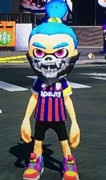To answer (1), InfiniteReality. InfiniteReality is InfiniteReality. InfinitePerformance is Octane2 graphics in an onyx box called a V-brick.
IP: "this product provides an economical advanced visualization solution for polygon-intensive applications."
IR: "The ultimate solution for the most challenging demands"
http://www.sgi.com/pdfs/3468.pdf

Quote:
2) For IP, how many pipes/nodes could be linked together to create a single system? Is it as expandable as the IR graphics?
Depends on the size of the system

2-way O300 vs. 128 way O3000 etc..
Quote:
3) For IP, does having multiple pipes/nodes linked together allow for a faster graphics system, or does it only allow more monitors, but the same as a single pipe (like a stand alone V12).
You can combine
IIRC
up to 4 IP pipes (2 vbricks, 2 pipes per brick) with a special compositor box. Recondas has/had one.
Quote:
4) Is it possible to use any of the Origin 3xxx based systems and add in graphics? (either IR, or IP)
for the most part, yes.
Quote:
5) Is it possible for a system - like an Octane, Fuel, Tezro - to connect to an IR or IP pipe and use that instead of the built in graphics?
No.
Quote:
6) I know that the IR is capable of 8x antialiasing, but is that feature only enabled if the software is calling for it? I.E. in Maya, there is no way to force the graphics system to antialias the viewport, but would an IR system draw the graphics with antialiasing by default?
IME most applications that support it will do it automatically but I would have to fire up Maya and check it out for myself.

 (Maradona)
(Maradona)
 (DavidVilla) A1186 (Xavi) d800 (Pique) d820 (Neymar)
(DavidVilla) A1186 (Xavi) d800 (Pique) d820 (Neymar)





 How long do tax records need to be stored? 7-10 years?
How long do tax records need to be stored? 7-10 years?
 (the earlier link, I mean)
(the earlier link, I mean)
 The people here are Infinitesimally more friendly then they are in my hometown of Ottawa CA (where everybody is rude and in a hurry with their over-inflated sense of self-worth etc. Can't get a bag of milk from the shops without being run over by some yuppie and her shopping cart. Toronto is just as bad if not worse. The real canucks say life is better out west, but I'm not much of a farmhand or oil tycoon so there wouldn't be much for me to do) Living in Baarn was nice (Netherlands) and I have most family still in those parts mainly Amsterdam. But I'm here now, and not there, so unless I can arrange for employment before moving to the old world I'm staying put
The people here are Infinitesimally more friendly then they are in my hometown of Ottawa CA (where everybody is rude and in a hurry with their over-inflated sense of self-worth etc. Can't get a bag of milk from the shops without being run over by some yuppie and her shopping cart. Toronto is just as bad if not worse. The real canucks say life is better out west, but I'm not much of a farmhand or oil tycoon so there wouldn't be much for me to do) Living in Baarn was nice (Netherlands) and I have most family still in those parts mainly Amsterdam. But I'm here now, and not there, so unless I can arrange for employment before moving to the old world I'm staying put
 2-way O300 vs. 128 way O3000 etc..
2-way O300 vs. 128 way O3000 etc..











